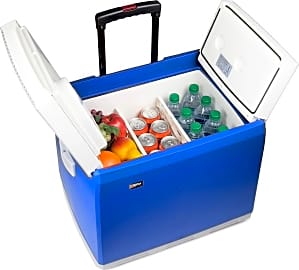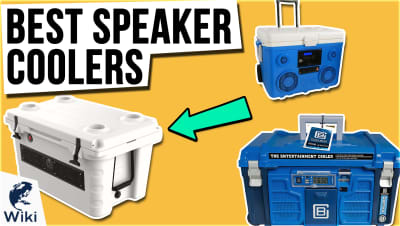The 10 Best Electric Coolers

This wiki has been updated 41 times since it was first published in March of 2015. Reaching into the cooler at a campground or tailgate party only to find the contents drowning in a sea of melted ice can put a real damper on the festivities. But with an electric model from our handy assortment, you can perform some game-day heroics and be a road-tripping master, knowing your snacks and beverages will stay frosty long after the rest are wilting in the watery depths. When users buy our independently chosen editorial selections, we may earn commissions to help fund the Wiki.
Editor's Notes
November 02, 2020:
Since the Suaoki Portable and Wagan Fridge/Warmer are no longer available, we removed them from the list. We also excluded the Norcold NRF30 because a few users complained it stopped working after a few months, or there were issues with the power cord not making contact.
We replaced the Wagan Fridge/Warmer with the Wagan EL6244. Although the latter is double the cost, it also offers nearly double the capacity (46 quarts). The JoyTutus 26-Quart proved to be more reliable than the Norcold NRF30. It features an LED panel, battery protection switch, and USB charging port. Plus, you can plug it into a standard electric outlet, a car lighter, or battery. We also included the Coleman PowerChill despite complaints about the motor burning out. After careful research, we determined that more than likely, the issue was caused by users placing the unit too close to other items. Thus, blocking the airflow.
For a look at other models, check out the reviews for soft coolers, speaker coolers, and wheeled coolers on this website.
May 02, 2019:
While it may be pricey, the Dometic Dual Zone is a heavy-duty cooler that's built to last, with reinforced corners and stainless steel hinges, and it works well even when it's extremely hot outside. Its high-performance compressor is surprisingly energy-efficient, can be charged via AC, DC, or solar power, and has a three-stage protection system that ensures you never end up with a dead car battery. The Alpicool C20 and Costway Compact are both designed to stand up to heavy vibration, making them great for boating and off-roading.
Several of the models on our list have both heating and cooling options, including the Suaoki Portable, Koolatron Voyager, Cooluli Mini Fridge, and Wagan Fridge/Warmer. The warming function is especially useful for transporting food to a potluck or keeping baby bottles warm while traveling. The Cooluli Mini Fridge is a tiny model that can hold six 12-ounce cans or four 16-ounce bottles, so it's great for a dorm or a teenager's room. If you have a lot of skincare products, it's also a good size for keeping temperature-sensitive serums and face masks cool.
Special Honors
Rockpals Electric Cooler/Warmer The Rockpals Electric Cooler/Warmer uses a thermoelectric system and features a brushless motor and convection fan. It has a 26-quart capacity and cools from 50 to 32 Fahrenheit within eight minutes. It also comes with a 12-volt power cord and is backed by a two-year warranty. rockpals.com
Keeping Your Cool!
The hot side of the device is also attached to a heat sink, which keeps it at ambient temperature.
So you're getting ready for that family camping trip or exciting tailgating party, but you really don't want to worry about stopping at gas stations to pick up bags of quickly-melting ice just to keep your food and drinks cold along the way.
You want convenience, not to be stuck drinking warm soda or eating a soggy turkey sandwich in the middle of nowhere if you don't have to. After all, why should you or your family have to sacrifice the quality of a refreshment just because you happen to be traveling? The truth is, you don't have to.
The portable electric cooler solves many basic travel problems when it comes to eating, drinking, or entertaining on the go. This is accomplished through the thermoelectric cooling principle.
Thermoelectric cooling technology is the driving force behind the operational convenience of your portable electric mini-fridge. Thermoelectric coolers use what's known as the Peltier effect, which describes the process of an electrical current being applied across a junction between two dissimilar metals. With this effect, heat from one side of the device is transferred to the other. The hot side of the device is also attached to a heat sink, which keeps it at ambient temperature. This allows the cold side to drop below room temperature.
You might be thinking that the concept of a portable fridge is pretty simple and limited to a small consumer niche, but the fact is that in addition to keeping that turkey sandwich cold and crisp, thermoelectricity is also a simple and reliable source for power generation in other applications, including space and interplanetary travel.
The innovation of Radioisotope Thermoelectric Generators (RTG), for example, has been used by NASA for a variety of missions, including Apollo, Pioneer, and Voyager among others. Such technology provides simplicity without the need for reliance on solar energy. This allows the power source to run for years because there are very few moving parts to be concerned with. The same can be said for your electric cooler. Few moving parts means minimal energy output and less of a drain on your car's power source.
It's What Your Cooler Can Do For You
Electric coolers offer a degree of versatility not found with conventional refrigerators. Aside from the obvious fact that they're portable, these coolers are small and compact, making them terrific solutions for long road trips. They're easy to open/close and many offer thick insulation to maintain a constant temperature. Many available cooler models can be used both upright or as a storage chest and deliver multiple shelving options.
Your guests might not appreciate reaching into a chest full of water to fish for their beverage.
Additionally, the electric cooler doesn't require the use of ice to keep things cold. Somehow, the idea of your food or drink sitting in a pool of melting ice doesn't give you a lot of confidence that it's being kept in the freshest of environments. An iceless cooler, by contrast, keeps things fresh for extended periods of time.
Finally, imagine that you're hosting a tailgating party and want to give your guests ice-cold beers. Your guests might not appreciate reaching into a chest full of water to fish for their beverage. Removing ice from the picture makes your life easier in that regard, since your guests' hands stay dry. You also don't have to worry about finding a place to drain all that excess water. Using thermoelectric cooling technology eliminates the need for wasting those resources, while remaining friendly to the environment so that you can actually enjoy that party without any guilt.
The Evolving Cooling Effect
Early studies of thermoelectricity began before the world wars in western Europe by academic scientists centered in Berlin. In 1821, Thomas Johann Seebeck discovered that an electric circuit made from two dissimilar metals, and with junctions at different temperatures, would deflect a compass magnet. Seebeck thought that this action was due to the magnetism induced by the temperature difference itself and that it may have had something to do with Earth's magnetic field.
This temperature difference produces an electric potential that drives an electric current within a closed circuit.
He later determined that it was a thermoelectric force that accounted for the electrical current and that it was the catalyst for the compass deflection. This temperature difference produces an electric potential that drives an electric current within a closed circuit. It is this process that came to be known as the Seebeck effect.
In 1834, French watchmaker (and part-time physicist) Jean Charles Athanase Peltier discovered that an electrical current would produce either a heating or cooling effect at the junction of two dissimilar metals, depending on the direction that the current was flowing. Peltier learned that heat could be removed from a junction in order to freeze water into ice, and that the current's direction could be reversed to generate heat to melt the ice instead. This directional dependence of an electrical current is known as the Peltier effect.
Twenty years later, William Thomson (later known as Lord Kelvin) offered a comprehensive explanation for both the Seebeck and Peltier effects, leading to a third discovery that heat is either absorbed or produced when an electrical current flows in a material with a temperature gradient. This effect is known as the Thomson effect.
The period between 1920 and 1970 was marked by a series of ups and downs for thermoelectric studies. However since 2000, the growing need for alternative energy sources has sparked new interest in the field, as well as renewed interest in using the technology to develop inexpensive and environmentally-friendly applications.















